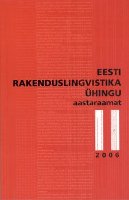Vastus jah - kas seda on vaja eraldi õpetada? Eesti jah ja vene да - funktsionaalsed erinevused telefonivestluste näitel
Functional differences between Estonian particle jah and Russian particle да in the telephone conversation
Author(s): Riina Kasterpalu, Olga GerassimenkoSubject(s): Language and Literature Studies
Published by: Eesti Rakenduslingvistika Ühing (ERÜ)
Keywords: conversation analysis; interaction in institutional settings; linguistic corpora; translation dictionaries; telephone conversation; response particles; Estonian as a foreign language; second language acquisition; Estonian; Russian
Summary/Abstract: The Estonian particles jah/jaa are described in the books of reference as the second pair parts of the adjacency pair, e.g an answer to a question and an affirmation of a statement, etc. However, the usage of these particles as continuers and acknowledgement tokens is not mentioned, whereas in telemarketing and outpatient department calls the particles jah/jaa are rather often used as continuers and acknowledgement tokens. These functions seem to have been underestimated both in the books of reference and second language pedagogy literature. However, they are crucial for second language acquisition, since the use of the Russian particle да is more limited than the Estonian jah/jaa. The use of particles other than jah/jaa in their genuine contexts in Estonian may demonstrate interaction inadequacy. The mere translation of particles in the current usage may not provide the expected reaction from the listener and can result in misinterpretation and interaction failure. A language learner can rely on both literature and native speakers’ help when acquiring vocabulary and grammar. While differences in the interaction patterns are considerably harder to ascertain, as native speakers are generally reluctant to indicate the interaction mistakes occurring in the non-native speakers’ talk. It is highly important to indicate the possibilities for pragmalinguistic failures in textbooks.
Journal: Eesti Rakenduslingvistika Ühingu aastaraamat
- Issue Year: 2006
- Issue No: 2
- Page Range: 025-042
- Page Count: 17
- Language: Estonian

